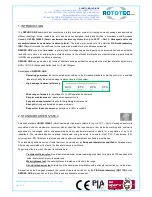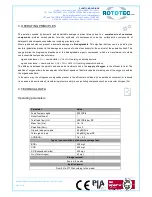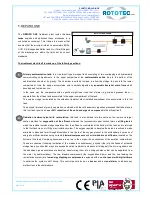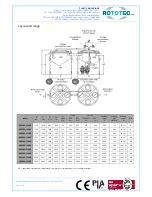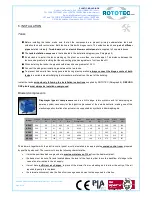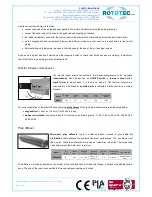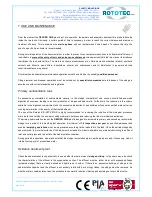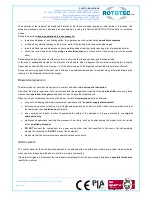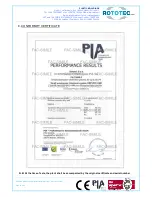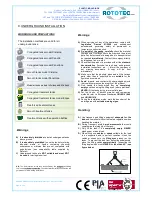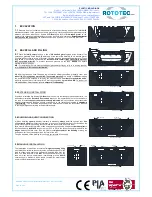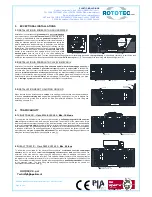
PLASTIC MOULDINGS
V
IA DELL
’
ARTIGIANATO
,
6
•
61026
LUNANO
(PU)
•
I
TALY
T
EL
.
+39
0722
722801
•
F
AX
+39
0722
70599
•
W
EB
:
www.rototec.it
E-
:
•
PEC
VAT
and TAX
CODE
01476690415
•
C
OMPANY
C
APITAL
.
120.000,00
CCIAA
(C
HAMBER OF
C
OMMERCE
R
EG
.
N.)
12602
P
ESARO
DEPURO ONE Use and Maintenance Manual, Rev. 00 of 27/01/2016
Page 8 of 13
7. USE AND MAINTENANCE
From the moment the DEPURO ONE plant is put into operation, the aerobic and anaerobic bacterial flora starts to develop
inside the two tanks. Obviously, a certain period of time is necessary in order to reach the correct balance and maximum
treatment efficiency. This is known as the start-up phase, and can last between 2 and 5 weeks. To reduce this time, the
use of a specific bio-activator is recommended.
During normal operation of the treatment plant, in order to prevent even temporary reductions in its treatment efficiency, it
is advisable to prevent the entry of toxic and poisonous substances unless previously diluted in a manner that reduces
their impact on the bacterial flora. The main toxic chemical substances are: chlorine and its derivatives (bleach), synthetic
solvents and diluents, weed killers, insecticides, mineral oils, substances used for disinfection in general and toxic
chemical substances in general.
All ordinary and extraordinary maintenance operations must be carried out by suitably qualified personnel.
Sludge removal and disposal operations must be carried out by specialist companies able to dispose of the sludge in
accordance with current standards and legislation.
Primary sedimentation tank
An excessive accumulation of sedimentable material in the sludge compartment can cause uncontrolled anaerobic
digestion phenomena, leading to an over-production of biogas and bad smells. Furthermore, the reduction in the volume
available in the digestion compartment and the excessive production of gas bubbles will cause the settled material to rise,
causing deterioration in the quality of the treated effluent.
The use of the Rototec BIO-ACTIVATOR is highly recommended for rendering the initiation of the biological processes
more rapid, thus limiting the number of sludge removal operations and reducing the risk of malodorous emissions.
The primary sedimentation tank of the DEPURO ONE plant is designed to accumulate primary and secondary recirculation
sludge for a period of 6-8 months plant operation. A minimum of 1-2 inspections per year by qualified personnel and
eventual emptying operations must be programmed according to the loads fed to the tank. Once the settled sludge has
been removed, the internal surfaces of the tank must be cleaned in order to eliminate any material obstructing the effluent
inlet and outlet pipes and the outlet of the sedimentation chamber.
During periodic inspections, also make sure that the sludge recirculation pipe is working properly and, if necessary, clean it
internally using a jet of pressurised water.
Oxidation treatment plant
Check the sedimentation tank periodically to see whether there are areas of sludge build-up. In the same way, also check
the characteristics of the effluent in the oxygenation section. The effluent must be rather clear, with suspended flakes
(activated sludge) that are clearly defined and light brown in colour. If there is an excessive build-up of sludge in the
sedimentation chamber and the effluent is excessively turbid with dark, stringy flakes, the sludge must be removed. As
with the primary sedimentation tank, the oxidation tank normally requires cleaning and pumping out every 6-8 months.


